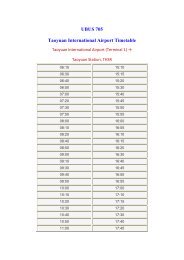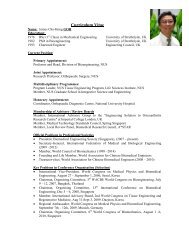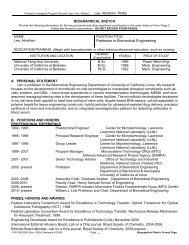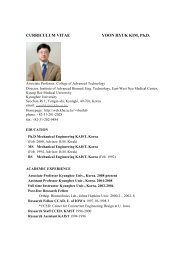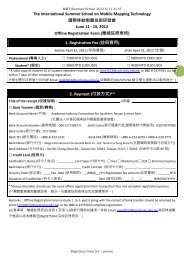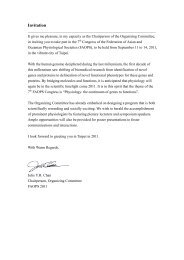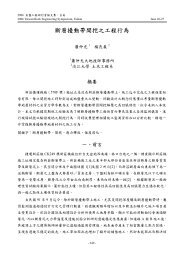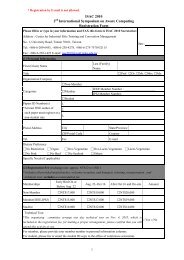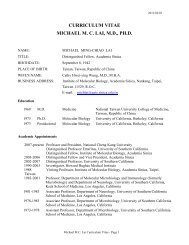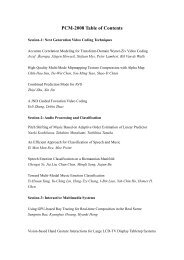Research Express@NCKU - Articles Digest
Research Express@NCKU - Articles Digest
Research Express@NCKU - Articles Digest
Create successful ePaper yourself
Turn your PDF publications into a flip-book with our unique Google optimized e-Paper software.
<strong>Research</strong> <strong>Express@NCKU</strong> - <strong>Articles</strong> <strong>Digest</strong>HOMO levels are estimated to be -5.74~-5.64 eV, respectively. Besides, the onset reduction potentials ofDCM-Br, PF and PFDs are in the range of -1.59~-0.64 V, with their LUMO levels estimated to be -3.70~-2.75 eV. From the HOMO and LUMO levels, the band gaps of the copolymers were estimated to be 2.93,2.93, 2.89, 2.89, 1.96, and 1.94 eV, respectively. It is noteworthy that the DCM-Br is a red-emittingchromophore with a small band gap (E g = 2.06 eV). Furthermore, the LUMO level of the DCM-Br unit isvery low (-3.68 eV), which is beneficial in promoting electron-transfer properties when incorporated inthe copolymers. The results show that all the copolymers have similar HOMO levels (-5.68~-5.64 eV),suggesting that oxidation starts at fluorene segments regardless of the DCM contents (HOMO of PF = -5.7 eV). However, although the LUMO levels of PFD0.5~PFD10 are the same (-2.75 eV), those of PFD25and PFD50 are much lower (-3.68~-3.70 eV). High LUMO levels in PFD0.5~PFD10 are due to their lowcontent of the DCM unit that make the reduction start at fluorene segments.Double-layer electroluminescent devices using the polymers as emitting materials [ITO/PEDOT/polymer/Ca/Al] were fabricated to investigate their opto-electronic characteristics. In EL spectra ofPFD0.5 and 01, the emission from fluorene segments (λ em = 426 nm) degenerates significantly, and avery intensive emission appears around 500~700 nm attributed to the DCM segments. However, the ELspectra of PFD5~PFD50 exhibit exclusively the longer wavelength emission band (λ em = 597~631 nm),which are mainly originated from DCM units. This indicates that excited energy transfers efficientlyfrom fluorene segments to DCM units due to the smaller band gap of the DCM units. Furthermore, withan increase in DCM ratios the emission peak (λ em ) red-shifts progressively from 555 nm to 631 nm, atendency similar to that observed in their PL spectra. The red-shifted emission peaks are ascribed toexcimers formed via intra- and/or intermolecular interactions. The maximal brightness and currentefficiency of the EL devices are 639~1719 cd/m2 and 0.086~0.3 cd/A, respectively. Specifically, themaximal brightness and current efficiency of PFD0.5 device are 1719 cd/m 2 and 0.25 cd/A, respectively.With an increase in DCM content, for instance in PFD1 and PFD5 devices, the current efficiency isenhanced further to 0.30 cd/A, although the maximum brightness drops slightly to 910 cd/m 2 .Figure 4. Electroluminescence spectra of the devices.In the EL spectra of blend devices Blend-20, Blend-10 and Blend-5, in which blending of PFD0.5 with PF4 of 5
<strong>Research</strong> <strong>Express@NCKU</strong> - <strong>Articles</strong> <strong>Digest</strong>and the values are the molar percents of PFD0.5 in the blends, the emissions are similar to that ofPFD0.5, but the peak intensity between 400 nm and 500 nm varies significantly. The EL emissionwavelength of the DCM units is situated around 550 nm, while those of fluorene moiety enhancesobviously with decreasing DCM contents (Blend-20→Blend-5). Accordingly, the 1931 CIE coordinates ofthe blend devices vary with the content of DCM units and are (0.33, 0.35) for Blend-20, (0.32, 0.34) forBlend-10 and (0.24, 0.20) for Blend-5, respectively. The 1931 CIE coordinates of Blend-20 and Blend-10considerably approach (0.33, 0.33) of white light.Figure 5. Emission spectra of the EL devices from PFD0.5, Blend-20, Blend-10, and Blend-5.In summary, copolyfluorenes containing DCM derivatives have been successfully synthesized by thepalladium-catalyzed Suzuki coupling reaction. In dilute solution, two major absorptions and twoemission bands were attributed to fluorene segments and DCM units, respectively. In the film state, theemission maximum originated from DCM segments gradually shifted from 560 nm to 596 nm, as thefraction of the DCM units was increased. The copolymers showed similar HOMO levels (-5.68~-5.64eV), but the LUMO levels lowered gradually (-2.75→-3.70 eV) with increasing the DCM units. In the ELspectra of PFD5~PFD50 devices, the emission maxima were situated 597~631 nm originated mainlyfrom DCM units. However, both emissions of PF and DCM were observed in PFD0.5 and PFD1. Themaximum brightness and current efficiency of PFD0.5 devices were 1719 cd/m 2 and 0.25 cd/A,respectively. With an increase of DCM content, for instance in PFD1 and PFD5 devices, the currentefficiency was enhanced further to 0.30 cd/A. Moreover, the EL devices of blends from PF and PFD0.5exhibited near white light emission, i.e. the CIE coordinates were (0.33, 0.35) and (0.32, 0.34) for Blend-20 and Blend-10, respectively. Current results suggest that blends of PFD and PF are potential emittingmaterials for white light devices.5 of 5
<strong>Research</strong> <strong>Express@NCKU</strong> - <strong>Articles</strong> <strong>Digest</strong><strong>Research</strong> <strong>Express@NCKU</strong> Volume 6 Issue 2 - October 17, 2008[ http://research.ncku.edu.tw/re/articles/e/20081017/2.html ]An optoelectronic measurement system formeasuring 6-DOF vibration motionCJ Chen (Chen, Chun-Jen) 1 ,PD Lin (Lin, Psang Dain) 1,* , WY Jywe(Jywe, Wen-Yuh) 21 Department of Mechanical Engineering, National Cheng Kung University2 Department of Automation Engineering, National Huwei University of Science and Technologypdlin@mail.ncku.edu.twOptics Express, Vol.15, no. 22, pp. 14601-14617, 2007.This paper has presented and verified a 6-DOF optoelectronicmotion measurement system [1] constructed from 3 laser-diode/PSDpairs and a pyramid-polygon-mirror. The skew-ray tracing was usedto model the system and determine the system equations forexpressing the 6-DOF motion. To improve computational speed forthis proof-of-concept paper, we employed a first-order Taylor seriesexpansion to obtain a linear form of the system equations. Theproposed system was validated using a laboratory-built prototype toperform calibration and stability experiments. Calculations showedposition and angular motion measurement ranges of ±3.5mm and±2.5, respectively. Stability testing for 5 minutes of continuous operation showed position and angularmeasurement variance in the range of ±1 μmand ±1.5 arc sec, respectively.Fig. 1: Schematic diagram of a 6-DOF motion measurement system with a 3-sided pyramid-polygonmirror.1 of 5
<strong>Research</strong> <strong>Express@NCKU</strong> - <strong>Articles</strong> <strong>Digest</strong>Fig. 2: Photograph of lab-built 6-DOF motion measurement system.A rigid body in 3D space may have three angular motionsand three translationalmotions. To measure all of these six motions simultaneously and accurately is achallenging task. Presently available PSDs are planar devices which output 2 readings capable ofmeasuring at most 2 DOF. Consequently, some arrangement of multiple sensors, lasers and mirrors isrequired to detect 6-DOF motions. Literature is meager for literature related to 6-DOF rotary systemmeasurement but includes 5-DOF motion error measurement of translational parts [2], 4-DOF motionmeasurement of an indexing (rotary) table [3] and 6-DOF measurement of vibration [4].The optoelectronic hardware of the proposed system employs 3 laser diodes and 3 2-axis PSDs and apyramid-polygon-mirror of three sides (see Fig. 1). The 3 laser diodes and 3 2-axis PSDs (UDT SC-10D,active area 100mm 2 ) are arranged evenly around the circumference of the pyramid-polygon-mirrorwhich is mounted rigidly and centered axially on the vibrating object to be measured. The light rays fromthe laser diodes (λ=635nm, 5mW) are projected onto the respective mirrors, then reflected to anddetected by the respective PSDs. Each PSD outputs the position of the incident light beam on the surfaceof the PSD along the axis in question. These relations can be expressed by Snell’s Law such that the unitdirectional vectors of a reflected laser ray depends on the unit normal vector of the mirrors.Consequently, the 6-DOF motions, and , of a vibrating object can bemeasured by the following equations:Figure 2 shows the lab-built prototype system with d=70mm. The outer mirrored surfaces of acommercial corner cube are used as a pyramid-polygon-mirror. Because no system can be fabricatedwithout manufacturing errors, each of the lasers and PSDs and the holder of the pyramid-polygon-2 of 5
<strong>Research</strong> <strong>Express@NCKU</strong> - <strong>Articles</strong> <strong>Digest</strong>mirror have pose adjustment mechanisms so that, during initial set up, the laser rays can be centeredin their respective PSDs at a table rotation of 0•. Mathematically, the resolution of position motions δand angle motions η are 0.106 μm and 0.274 arc sec, respectively, when an AD card (Advantech PCI-1716, 16 bit, sampling range ±10V, Max. sampling frequency 250kHz) is used. Each of the 6 DOFs istested independently to verify starting system function. Linear motion verification uses a 5-DOFmanual-stage that translates along the x-, y- and z-axes and rotates around the y- and z-axes bymanual adjustment, with an accuracy of 10 μm. Angular verification uses a manual rotary table andmanual goniometer. The rotary table rotates around the z-axis with an accuracy of 1•. The goniometerhas an accuracy of 5 arc min. Input-output curves for each DOF are obtained by manually making aseries of stepwise changes to the test table so as to adjust the position and angle motions δ and η overthe ranges of 3mm and ±0.5˚, respectively. These changes result in the PSD output changing overabout half the possible working area for linear motion and about 1/5 for angular motion. Theverification results for δ and η give standard deviations for system uncertainty, indicating accuraciesof 0.5 μm and 0.4 arc sec for position motion and angular motion, respectively.General system stability was evaluated under normal laboratory conditions (i.e. no specialtemperature or vibration isolation) by setting table rotation to 0•, warming up the system for about 15minutes and then continuously recording the output signal for 5 minutes. The results of this test showthat δ and η remain within±1μm and ±1.5 arc sec, respectively, over 300 sec. Finally, this prototypesystem was employed to measure 6-DOF position/angle motion of a rotary table (NewPort PM500-360). Figure 3 and Fig. 4 show the measured angular motion η z for our prototype system and ourlaboratory autocollimator (NewPort LDS Vector, measurement range: 400 arc sec), respectively. Itshould be remembered that our laboratory prototype data is for a 3-sided mirror while theautocollimator data is for a 24-sided mirror; hence the higher number of data points in theautocollimator’s curve, and demonstrating the significance of increasing the number of polygon faces.Comparison of the two plots (Fig. 3 and Fig.4) can validate the presented modeling.The foregoing has demonstrated and verified an optoelectronic system capable of high-precisionmeasurement of motion errors for all 6-DOF of a rotating object. If we were to employ enhanced datacollection and correlation, our presented system could easily yield rotational direction (slope of thePSD curve), angular velocity (rate of change of the slope), the momentary position of the rotating partas well as basic error motion. An increased number of polygon faces could allow constant monitoringof all these parameters, regardless of whether the rotary part was moving or static. If the mirror wereintegrated on the surface of the rotary part and a miniaturized laser/PSD array were included in ahousing built around the rotary part, a highly useful basic component would result.3 of 5
<strong>Research</strong> <strong>Express@NCKU</strong> - <strong>Articles</strong> <strong>Digest</strong>Fig. 3: The measured results of angular motion η z of a rotary table from the lab-built system (square,circle and triangle each equal one rotation of the rotary table).Fig. 4: Autocollimator results (with 24-sided mirror) for rotary table measurement.References[1].Chen, C.J., Lin, P.D., and Jywe W.Y. " An Optoelectronic Measurement System for Measuring 6-Degree-of-Freedom Motion Error of Rotary Parts," Optics Express,2007,15, pp. 14601-14617.[2].Lin, P.D. and Ehmann K.F. “Sensing of motion related errors in multi-axis machines,” ASME J.Dyn. Syst. 1996, 118, 425-433[3].Jywe,W.Y. ; Chen,C.J. ; Hsieh,W.H.; Lin, P.D.; Jwo, H.H. and Yang, T.Y. “A novel simple and lowcost 4 degree of freedom angular indexing calibrating techniques for a precision rotary table,” Int. J.Mach. Tool Manu. , 2007,47, 1978-1987.[4].Bokelberg,E.H.; Sommer III,H.J. and Trethewey,M.W. “A six-degree-of-freedom laser vibormeter,part I and II,” J. Sound Vib., 1994, 178, 643-667.4 of 5
<strong>Research</strong> <strong>Express@NCKU</strong> - <strong>Articles</strong> <strong>Digest</strong>5 of 5
<strong>Research</strong> <strong>Express@NCKU</strong> - <strong>Articles</strong> <strong>Digest</strong><strong>Research</strong> <strong>Express@NCKU</strong> Volume 6 Issue 2 - October 17, 2008[ http://research.ncku.edu.tw/re/articles/e/20081017/3.html ]HDD AND CDD OPTION PRICING WITHMARKET PRICE OF WEATHER RISK FORTAIWANHung-Hsi Huang 1 , Yung-Ming Shiu 2,* , Pei-Syun Lin 31 Graduate Institute of Finance, National Pingtung University of Science & Technology, 1, HseuhFu Road, Neipu, Pingtung 91201, Taiwan2 Department of Business Administration, National Cheng Kung University, Tainan, Taiwan3 Cathay United Bank, Taichung, Taiwanyungming@mail.ncku.edu.twJournal of Futures Markets, Vol. 28, No. 8, 790-814 (2008)In the past few years, we have witness the tremendous growth of derivativecontract in terms of volume. In order to meet the demand of arbitrager,hedgers and speculators, different types of derivatives are newly designed andtransacted on the market. One of the types of derivatives which are gettingpopular is weather derivatives. The main reason why weather derivatives aremore and more important is that many sectors whose business profits aredirectly related to variations in weather, e.g., the farming industry, the energysector, and theme parks.Weather derivatives are relatively new to Taiwan. With a view to develop localized weather derivatives, itis necessary to price such derivatives with market price of weather risk. To date, however, there is nouniversally recognized approach to pricing these contracts. It should be noted that pricing weatherderivatives is different from pricing traditional derivatives, because the payoff from weather derivativesis dependent on weather indexes which are calculated based on temperature, rather than the price ofcash market instruments such as stocks, currencies, interest rates, and commodities. Because theunderlying assets of weather derivatives, weather indexes, are not tradable, we cannot use the arbitragefreeapproach to pricing weather derivatives. Moreover, temperature follows a mean reverting processand the temperature derivatives market is incomplete. Therefore, we cannot apply the Black-Scholesformula to price such derivatives. So far, some methods have been proposed to price weather derivatives,such as burn analysis.This research further develops the long-term temperature model proposed in prior studies by taking intoaccount ARCH/GARCH effects to reflect the clustering of volatility in temperature. We employ adatabase of daily maximum and minimum temperatures measured in degrees Celsius over the 1974-2003 periods. A sample of 21,900 daily highs/lows is obtained from the Central Weather Bureau,Taiwan. As shown in Figures 1a and 1b, the temperature has been oscillating and has increased oversample time. These characteristics justify the inclusion of seasonality and trend of temperature in themodel. Having investigating the graphs and descriptive statistics of daily average temperature andresiduals of ordinary least squares for the model for temperature, we further find that the distributionsfor daily average temperature and residuals are platkurtic and leptokurtic respectively and that both ofthem are negatively skewed. In our research, both the fixed variance model and the ARCH model are1 of 3
<strong>Research</strong> <strong>Express@NCKU</strong> - <strong>Articles</strong> <strong>Digest</strong>estimated. As shown in Figure 2, for HDD/CDD the call price is higher under ARCH-effects variancethan under fixed variance, while the put price is lower.FIGURE 1a, Daily highest temperature (1997-2003)FIGURE 1b, Daily lowest temperature (1997-2003)2 of 3
<strong>Research</strong> <strong>Express@NCKU</strong> - <strong>Articles</strong> <strong>Digest</strong>FIGURE 2, HDD/CDD call/put option prices with fixed and ARCH-effects variances under differentmarket prices of risk3 of 3
<strong>Research</strong> <strong>Express@NCKU</strong> - <strong>Articles</strong> <strong>Digest</strong><strong>Research</strong> <strong>Express@NCKU</strong> Volume 6 Issue 2 - October 17, 2008[ http://research.ncku.edu.tw/re/articles/e/20081017/4.html ]Ab initio studies of the possible magnetism bynonmagnetic defects in a BN sheetRu-Fen Liu, Ching Cheng *Department of Physics, College of Sciences, National Cheng Kung Universityccheng@mail.ncku.edu.twPhys. Rev. B 76, 014405 (2007)This study attempts to resolve the following two issues: 1) whether a longrangemagnetic order can be established in a material consisting of elementsholding only s and p valence electrons, 2) whether the magnetic properties,similar to the electrical properties, can be controlled through defects in theprevious systems. Magnetism involving only s- and p-electron elementsattracts considerable attention due to the potential for extensive applicationsas well as the urge to understand its physical origins. Recently, possibleferromagnetism in fullerenes and graphite systems were discoveredexperimentally while the theoretical studies attempting to find magnetism in some potentialnonmagnetic systems were also carried out. However, the origin of ferromagnetism in those systems isstill under debate. Through studying different defects concentrations in a 2D system of BN sheet by thefirst-principles methods, we found that, despite most of the defects doped BN sheet only lead to theformation of local moments, there are systems exhibiting long-range ordered magnetic moment ofestimated T C ≈70K.BN can form three different bulk structures, i.e. hexagonal, cubic and wurtzite BN. Of these threestructures, hexagonal BN (h-BN) is the room temperature phase. Similar to graphite, h-BN is quasi-2Dwith weak interaction between layers. Nevertheless, unlike the delocalized electrons in graphite, thedifferent electronegativity of B and N leads to directional binding and thus a wide band gap of at least 4eV in h-BN. The tubular BN has been synthesized experimentally and it was shown that the BNnanotubes rolled up in different ways are all semiconductors. One would therefore expect that theeffects of defects in a BN sheet would similarly take place in BN nanotubes.FIG 1. 4x4 unit cell for the h-BN sheet. D represents defects created in the system, i.e. impurities ofvacancies.1 of 5
<strong>Research</strong> <strong>Express@NCKU</strong> - <strong>Articles</strong> <strong>Digest</strong>In this work, two types of defects are used to study the possible magnetism in a BN sheet, i.e. vacanciesby removing either B or N atoms (denoted by V B and V N ) and impurities of the Be, B, C, N, O, Al and Siatoms substituting for the B or N atom (denoted by, e.g. C B for C impurities substituting for B atoms) asshown in FIG.1. The calculations are based on density functional theory with the generalized gradientapproximation for the exchange-correlation energy functional. The projector augmented-wave methodis used to describe the core-valence electron interactions. Supercells composed of 4×4 primitive unitcells of BN sheet are used to simulate systems with defects. The larger supercells of 8×4 and 8×8 wereused to study the possible finite magnetic moments induced by defects, as well as the variation of themagnetization energy (E M ) and the exchange energy J with respect to the distances between defects(d D ), i.e. the defect concentrations.FIG 2. Orbital-projected partial DOS for N and B atoms in a BN sheet.The density of state (DOS) for the BN sheet consists of two valence bands (denoted as VB1 and VB2hereafter as in FIG.2). The DOS’s are mostly p z -orbital-like near the top of VB2 and the bottom of CB.However, the dominant contribution switches from the p z orbital on N atoms near the top of VB2 to thaton B atoms near the bottom of CB. That is, the electronic excitation in the BN sheet involves displacingthe originally p z -orbital electron distribution around the N atoms towards the space around the Batoms.2 of 5
<strong>Research</strong> <strong>Express@NCKU</strong> - <strong>Articles</strong> <strong>Digest</strong>FIG 3. Schematic diagrams of the effect of defects on DOS. The dashed lines show the possiblecircumstances in forming metal-like DOS.The effect of defects on DOS is summarized schematically in FIG.3 which demonstrates the two possibletypes of formation for the defect bands. For N B , C B , O B , O N and Si B , the bonding abilities of theimpurities are stronger than the substituted host atoms (type I) while for Be B , Be N , B N , C N , Al N , and Si N ,the weaker bonding ability drives the defect bands (DBs) to the higher-energy region of the originalbands. The order in the bonding ability is found to be consistent with the electronegativity order basedon the Mulliken scale. The partially occupied defect bands for O N and Si B (Be B and O N ) are located atthe edge of the original extended CB (VB2) bands which are more likely to be extended in nature andthus lead to larger exchange energies as presented later. Of these studied defect systems, some consist ofeven numbers of electrons in the supercell, i.e. N B , B N , Al B , and Al N . The even numbers of electrons inthe supercell completely fill up the DBs, i.e. no formation of finite moments, and they are thereforeexcluded from the following discussions. The calculated magnetic moments in Be B and V B were found tovary as d D increases. However, their magnitudes converge to 1μ B as d D increases to 17.37 Å. For the restdefect systems, the calculated magnetic moments are always found to be 1μ B and independent of d D .3 of 5
<strong>Research</strong> <strong>Express@NCKU</strong> - <strong>Articles</strong> <strong>Digest</strong>FIG 4. Magnetization energy E M vs d D .To understand how stable these finite moments in the BN sheet are, the magnetization energies, i.e. E M ,obtained from the total-energy difference between the systems with and without spin-polarizedconfiguration were calculated (FIG.4). The E M ’s of these systems tend to increase as d D increase whichsuggests a definite preference for finite magnetic moments for those defect systems with distantnonmagnetic defects. Note that the defect concentrations of 3.125% and 0.78% correspond to a d D of10.03 Å and 20.05 Å respectively.4 of 5
<strong>Research</strong> <strong>Express@NCKU</strong> - <strong>Articles</strong> <strong>Digest</strong>FIG 5. Exchange energy 8J vs d D .To identify the possible long-range magnetic ordering in these systems, the Heisenberg type of spincoupling is employed to model the interaction J between the nearest-neighbour magnetic moments dueto defects (FIG.5). There are only two systems, i.e. O N and V B , which have large enough exchangeenergies to be identified numerically as magnetically ordered systems. Within the framework of theHeisenberg model, it is possible to estimate the Curie temperature (T C ) while the estimated values(T MF C ) from the present treatment are expected as the upper bound. For O N systems with a defectconcentration of 3.125%, the T MF C can reach up to 72K. In summary, we have demonstrated that all thestudied defect systems with partially filled defect bands exhibited a definite preference for finitemagnetic moments. The magnetic properties can depend on the defect concentrations and a long-rangemagnetic order is likely to occur in the systems of high defect concentration like O N and V B whose defectbands are extended in nature.5 of 5
<strong>Research</strong> <strong>Express@NCKU</strong> - <strong>Articles</strong> <strong>Digest</strong><strong>Research</strong> <strong>Express@NCKU</strong> Volume 6 Issue 2 - October 17, 2008[ http://research.ncku.edu.tw/re/articles/e/20081017/5.html ]Repeated cocaine exposure impairs theinduction of long-term depression in ratmedial prefrontal cortexChiung-Chun Huang 1 , Ping-Chun Yang 1 , Hsiao-Ju Lin 1 , and Kuei-SenHsu 1,2,*1 Department of Pharmacology, College of Medicine, and 2 Center for Gene Regulation and SignalTransduction <strong>Research</strong>, National Cheng Kung University, Tainan 701, Taiwanrichard@mail.ncku.edu.twThe Journal of Neuroscience (2007) 27: 2958-2968.IntroductionRepeated exposure to psychostimulants, such as cocaine andamphetamine, produces a progressive and enduring increasein their locomotor stimulatory effects. This enhancedbehavioral response is generally referred to as behavioralsensitization and is postulated to contribute to drug cravingand relapse to addiction. Many recent studies on theneurobiological basis of behavioral sensitization havefocused on the mesolimbic dopaminergic system becausecocaine and amphetamine act to block the reuptake orstimulate the release, respectively, of dopamine within this system. The mesolimbic system consists ofdopamine perikarya located in the ventral tegmental area (VTA) that project to numerous limbic areasincluding nucleus accumbens (NAc). Furthermore, cumulative evidence suggests that adaptive changeswithin the VTA appear to mediate the induction of behavioral sensitization, whereas adaptations in theNAc are involved in its long-term maintenance. Besides the mesolimbic system, recent studies haveimplicated an important role for the mesocortical system, in particular the medial prefrontal cortex(mPFC), in the development of behavioral sensitization. For example, direct electrical stimulation of thePFC leads to rewarding effects and sensitization to cocaine, whereas lesion of the PFC or impairment ofmesocorticolimbic glutamatergic transmission prevents the development of cocaine-induced behavioralsensitization. Furthermore, evidence is accumulating that the alterations of multiple mPFCneurotransmitter systems, including dopamine, serotonin, glutamate, noradrenalin, acetylcholine,GABA and peptides, and signaling by receptors activated by these neurotransmitters may also contributeto the development of cocaine sensitization and addiction.Accumulating evidence indicates that drug-induced synaptic plasticity may contribute to thereorganization of neural circuitry that underlies behavioral sensitization to drugs of abuse and thus thedevelopment of addiction. It has been shown that a single or repeated exposure in vivo to addictivedrugs induces alterations of synaptic transmission and/or long-term synaptic plasticity at excitatorysynapses in in vitro slice preparations of the VTA, NAc, periaqueductal gray, hippocampus, andstriatum. Less work has been done on the impact of in vivo exposures to drugs of abuse on excitatorysynaptic transmission in the mPFC. Our laboratory has recently demonstrated that repeated cocaine1 of 5
<strong>Research</strong> <strong>Express@NCKU</strong> - <strong>Articles</strong> <strong>Digest</strong>administration in vivo can promote the induction of long-term potentiation in layer V pyramidalneurons of mPFC. However, the effect of repeated cocaine exposure on the induction of long-termdepression (LTD) at mPFC excitatory synapses has not yet been explored. Here we provide the firstevidence that repeated cocaine administration, which produces sensitization of locomotor activity,impairs the group II metabotrophic glutamate receptor (mGluR)-mediated LTD at these synapses.ResultsWe first examined whether repeated cocaine administration affects the induction of LTD at mPFCexcitatory synapses. To induce LTD, we used a brief bath-application of DCG-IV protocol that has beenshown to effectively induce LTD in rat mPFC in vitro. Bath application of DCG-IV (0.2 μM) for 10 minreliably induced a robust LTD of excitatory postsynaptic currents (EPSCs) of layer V pyramidal neuronstermed DCG-IV-LTD in slices from rats treated with saline for 5 days (Fig. 1). This DCG-IV-induced LTDwere completely blocked by bath application of either MCPG (0.5 mM), a non-selective antagonist ofgroup II mGluR, or MSOPPE (100 μM), a more selective antagonist of mGluR2, suggesting that they aremainly mediated by the activation of group II mGluRs. In contrast, the induction of LTD by DCG-IV wassignificantly impaired in slices from rats treated with cocaine for 5 days. No change in the extent of DCG-IV-LTD was observed in slices from rats that were given a single injection of saline or cocaine. Theseresults suggest that repeated but not single cocaine administration impairs the induction of group IImGluR-mediated LTD in layer V pyramidal neurons of the mPFC.Given that cocaine can blocks the dopamine reuptake transporter and thus acutely increases localdopamine concentrations in brain areas receiving dopaminergic inputs, it is therefore possible thatactivation of dopaminergic receptors in critical brain areas is required for the aforementioned cocaineinducedimpairment of DCG-IV-LTD induction. To examine the role of these dopaminergic receptorsubtypes, we administrated specific D 1 - or D 2 -like receptor antagonists before cocaine injection. Neitherthe D 1 receptor antagonist SCH23390 (0.5 mg/kg) nor the D 2 receptor antagonist raclopride (0.5 mg/kg) had a significant effect on DCG-IV-LTD when administered with saline. When co-administered withcocaine, SCH23390, but not raclopride, DCG-IV-LTD was not blocked in slices from 5-day cocainetreatedrats. However, in contrast to SCH23390, the specific 5-HT 2C receptor antagonist RS102221 didnot significantly affect the impairment of DCG-IV-LTD seen in slice from 5-day cocaine-treated rats.These results suggest that the activation of D 1 -like receptors is responsible for the inhibitory effect ofrepeated cocaine administration on DCG-IV-LTD in the mPFC.2 of 5
<strong>Research</strong> <strong>Express@NCKU</strong> - <strong>Articles</strong> <strong>Digest</strong>Figure 1. Repeated cocaine exposure inhibits the induction of DCG-IV-LTD in mPFC layer Vpyramidal neurons. A and B, Example and summary of normalized EPSC slope before and after a briefapplication of DCG-IV (0.2μM) for 10 min in slices from rats treated with saline (A) or cocaine (B) for 5days. C and D, Summary of experiments showing the effect of DCG-IV on the EPSC slope in slices fromrats treated with a single dose of saline (C) or cocaine (D) for 1 day.The potential involvement of adenosine A 3 receptor activation in the development of cocaine-inducedimpairment of DCG-IV-LTD was also investigated. Bath application of specific adenosine A 3 receptoragonist Cl-IB-MECA (1μM) for 20 min had no significant effect on baseline synaptic transmission atmPFC excitatory synapses but significantly blocked the inhibitory effects of DCG-IV on EPSCs in slicesfrom control rats. The action of Cl-IB-MECA was blocked completely by either MRS1220 (10μM), aselective antagonist of adenosine A 3 receptor, or Bis-I, suggesting this effect is mediated by theactivation of adenosine A 3 receptors and protein kinase C (PKC)-dependent signaling pathway. To better3 of 5
<strong>Research</strong> <strong>Express@NCKU</strong> - <strong>Articles</strong> <strong>Digest</strong>characterize the role of adenosine A 3 receptors in the development of cocaine-induced impairment ofDCG-IV-LTD, MRS1220 was bilateral intra-mPFC infusion before each of the five daily cocaineinjections. We found that MRS1220 prevents the cocaine-induced impairment of DCG-IV-LTDinduction. DCG-IV induced a stable LTD in mPFC layer V pyramidal neurons in slices from rats treatedwith cocaine plus MRS1220 for 5 days to a similar extent as that observed for rats treated with salineplus MRS1220 for 5 days. These results suggest a role of adenosine A 3 receptor-mediated PKC activationin triggering the inhibitory effect of repeated cocaine treatment on the induction of DCG-IV-LTD.ConclusionIn conclusion, our data clearly indicate that repeated cocaine exposure in vivo can impair the inductionof group II mGluR-mediated LTD in the mPFC by a PKC-dependent mechanism. Our data also indicatethat higher levels of adenosine subsequent to the rise in cAMP following D 1 -like receptor activation mayactivate adenosine A 3 receptors, increase PKC activation and thereby block group II mGluR function(Fig. 2). Such a change may underlie some of the previously reported changes in glutamatergictransmission in the mPFC that occur after repeated cocaine administration and could also be involved inbehavioral neuroadaptations associated with cocaine sensitization and craving. Targeting of this druginducedalteration of synaptic plasticity might be a potential therapeutic strategy for the treatment ofdrug abuse and addiction.4 of 5
<strong>Research</strong> <strong>Express@NCKU</strong> - <strong>Articles</strong> <strong>Digest</strong>Figure 2. Schematic model illustrating the proposed mechanism for the impairment of group IImGluR-mediated LTD induction in the mPFC following chronic cocaine exposure.5 of 5
<strong>Research</strong> <strong>Express@NCKU</strong> - <strong>Articles</strong> <strong>Digest</strong><strong>Research</strong> <strong>Express@NCKU</strong> Volume 6 Issue 2 - October 17, 2008[ http://research.ncku.edu.tw/re/articles/e/20081017/6.html ]In Vivo Optical Biopsy and MolecularMicrotomography Imaging UsingNanoparticle ProbesShih-Peng Tai 1 , Yana Wu 2 , Tze-Ming Liu 1 , Chien-Huei Chang 2 , Xuan-Yu Shi 2 , Kuan-Jiuh Lin 3 , Chi-Kuang Sun 1 , Dar-Bin Shieh 2,4,5,*1 Department of Electrical Engineering and Graduate Institute of Photonics and Optoelectronics,National Taiwan University2 Institute of Oral Medicine and Institute of Basic Medical Sciences, National Cheng KungUniversity3 Department of Chemistry, National Chung Hsing University4 Department of Stomatology, National Cheng Kung University Hospital5 Institute of Basic Medical Sciences, National Cheng Kung UniversityEmail:dshieh@mail.ncku.edu.twAdvanced Materials 2007 19: 4520-4523.Optic Express 2006, 14(13)6178-6187Pathological diagnosis has long been recognized as the ultimate standard of diseasediagnosis. However, the clinical biopsy process is usually uncomfortable and at risk forcomplications such as bleeding, tissue trauma, seeding of malignant cells and so on forthe patient. For clinical doctors, selection of appropriate site for correct pathologicaldiagnosis of disease could be a challenge when dealing with multiple or large lesions.Recent advancement of non-invasive medical imaging technology has provided betterspatial resolution of anatomical details and molecular information of diseases. For example, highmagnetic field MRI imaging technology combined advanced coil design and imaging pulse sequence wasable to approach a spatial resolution of around hundred micrometers. However, all these imagingtechnologies still failed to reach a cellular or sub-cellular level of resolution. In a series of reports, wehave developed non-invasive, stain/label free, high resolution in vivo tomographic virtual biopsy systemthrough endogenous non-linear optical properties of biological molecules and histological structures. Ina following research, we have advanced the system with molecular imaging capability using the nonlinearoptical property of targeting-probe-conjugated nanoparticles.Third-harmonic-generation (THG) has been emerged as an important noninvasive intravital imagingmodality of in vivo biological research in recent years with the advantages including intrinsic opticalsectioning capability due to the high order nonlinearity nature and no energy release due to the virtualstate-transitioncharacteristic, thus allowing much improved cell viability in contrast to currentabsorption based fluorescence technologies. Harmonic generation imaging also provides high spatialresolution in tomography and therefore provide 3D structural information of the whole lesion andadjacent tissues. A great potential in the future development of this technology in the clinical diagnosticimaging and stem cell research that required minimal stimulation to the cells are expected.Previous harmonic generation imaging mostly used forward transmission mechanism and thus limited1 of 6
<strong>Research</strong> <strong>Express@NCKU</strong> - <strong>Articles</strong> <strong>Digest</strong>their clinical applications. We modified our optical design for backward mechanism and used Cr:forsterite laser as the light source. A pair of galvano mirror was used to control the X-Y scanning of thefiled. A pair of PMT was used to pick up the photon signal. For long time in vivo observation of theanimal model, we have integrated anesthesia and body temperature control to keep vital signs inphysiological range during imaging acquisition process (figure 1).Figure 1. Schematic illustration of the higher harmonic generation imagingacquisition system (http://www.opticsinfobase.org/abstract.cfm?&uri=oe-14-13-6178).Molecules with repetitive structures usually exhibit strong second harmonics optical property. Theseinclude many biomolecules such as cytoskeleton, collagen, elastin, etc. It is conceivable that harmonicgeneration imaging could well be applied for molecular topographic imaging for biomolecules in thetissue. In addition, although THG nonlinearity exists in all bio-materials, the Gouy phase shift effectsubstantially limits THG to be observed in the vicinity of interfaces where the first order or third ordersusceptibility discontinues. Therefore, THG is generally regarded as a morphological imaging for cellularstructures such as special domains in cellular membrane, nucleus, etc. The following figure presents aseries of tomographic in vivo imaging for normal oral mucosa (left) versus oral cancer lesions (right) in alive hamster by harmonic generation optical system (Figure 2). The blue channel in the images camefrom third harmonics signals and mostly distributed in the intercellular junction of normal oral mucosalepithelium. The green fibrous structure was collected from the second harmonic signals from collagenfibers in the dermis. The image quality provided more detailed information for the orientation, density,and distribution of the fibers compared to traditional H&E stain in pathological sections. On the onehand, collagen could only be visualized in deeper tissue and usually intermingled with cancerous cells incancer lesions. Prominent nucleoli and peri-nuclear granular structures could be clearly identified in the2 of 6
<strong>Research</strong> <strong>Express@NCKU</strong> - <strong>Articles</strong> <strong>Digest</strong>third harmonics imaging channel. Future investigation for the molecular biological meaning andmechanism for the cancer development are warranted.Figure 2. Normal oral mucosa (left) and oral cancer lesion (right) in a live hamster observed harmonicgeneration imaging system are illustrated. The blue color represents signals from the third harmonicsand the green color represents the second harmonics signal.In addition to the 3D tomographic imaging capability for pathological diagnosis of disease lesions, wealso demonstrated successful long term observation of live imaging in the tissues and pushed thesystem’s limit from 3D to 4D. As shown in figure 3, blood vessels and red blood cells in the vessels couldbe clearly identified in a time sequence of continuous acquisition. The area circled by white dot lines is ablood vessel. A movie clip could be downloaded or viewed on line via the following hyper link ( http://www.opticsinfobase.org/viewmedia.cfm?uri=oe-14-13-6178&seq=1 ). A slow repetitive motion of thewhole image area could be observed due to respiratory motion and pulse of the animal under anesthesia.Figure 3. Dynamic sequential acquisition of the combined second and third harmonic imaging for virtualbiopsy of oral mucosa tissue in a live hamster (from the left to the right panel = 0.3 second). The greencolor was generated from the second harmonics signal mainly contributed by collagen fibers. The redcolor represents third harmonics signals. The white dot lines represent a blood vessel in which biconcave3 of 6
<strong>Research</strong> <strong>Express@NCKU</strong> - <strong>Articles</strong> <strong>Digest</strong>shaped red blood cells flow through. Live images in video format are available online (http://www.opticsinfobase.org/viewmedia.cfm?uri=oe-14-13-6178&seq=1).Although THG nonlinearity exists in all bio-materials, the Gouy phase shift effect substantially limitsTHG to be observed in the vicinity of interfaces where the first order or third order susceptibilitydiscontinues. Therefore, THG is generally regarded as a morphological imaging tool due to this, withlimited capability for molecular imaging. It is thus highly desirable to develop exogenous THG contrastagents to trace the functions of a specific molecule, taking advantage of the noninvasive nature of theTHG process. Recently, noble metal nanoparticles have been proved to be able to enhance variousnonlinear optical signals through surface plasmon resonance. Hence, it should be ideal to adoptnanoparticles as molecular contrast agents of THG microscopy.With the help of surface plasmon-resonance, nanometer-sized noble metals can serve as a nanoscopicoptical resonant cavity. Metal nanoparticles with the plasmon resonance at the third harmonic of opticalexcitation, in the macroscopic point of view, is analogous to an optical third-harmonic oscillator. Wechose silver nanoparticles for its blue-violet plasmon resonance wavelengths when soaked in water. Fornonlinear biological in vivo imaging, near-infrared (NIR) femtosecond lasers as the THG excitationsources are preferred to increase the penetration depth and to reduce the potential optical damage. Inparticular, it has been demonstrated that the spectral transmission window of common biological tissuesfalls around 1200–1300 nm. With a 410-nm surface plasmon wavelength for THG resonance, thecorresponding NIR laser wavelength is 1230 nm, which concurs with the biological transparencywindow. In contrast, gold nanoparticles are with a surface plasmon resonance wavelength of 520– 560nm and the corresponding laser wavelength of 1560–1680 nm could suffer strong water absorption, thusnot suitable for in vivo biological imaging. Our recent spectral study of THG in silver nanoparticlesshowed evident THG enhancement when the third harmonic of the excitation matched the surfaceplasmon resonant frequency of silver nanoparticles, indicating that plasmon-enhanced silvernanoparticles could be an ideal contrast agent for THG microscopy.The Her2 molecule is one of the transmembrane receptor proteins for epidermal growth factors, andplays a key role in cell growth and anti-apoptotic signaling. The Her2 molecule is also important incancer development and clinical prognosis.Overexpression of Her2/ neu in cancer lesion is a predictorfor unfavorable clinical outcome with more aggressive growth behavior as well as resistance to somechemotherapy agents. To demonstrate molecular THG microscopy by using silver nanoparticles asexogenous THG contrast agents, the cultured mouse bladder carcinoma cells (MBT2) and the matchedcell line with knocked-down Her2/neu expression by RNAi were applied here. Western blot analysisrevealed the Her2/neu knocked-down cancer cell line, MBT2-KD, expressed only about 15 % the level ofthe wild type line, as shown in Figure 1a. The anti-Her2 antibodies tagged 30 nm silver nanoparticleswere then incubated with MBT2 and MBT2-KD for imaging of Her2 expression in cancer cells. Figure1b–d show the epi-THG images of the wild type MBT2 cells without and with the silver nanoparticlelabeling, and MBT2-KD cells with silver nanoparticle labeling. By comparing these THG images, brightspots on the wild type cancer cell cytoplasmic membranes can be clearly observed (Fig. 2d), in sharpcontrast to the MBT2-KD line (Fig. 1c) and in proportion to their endogenous Her-2 expression levels(Fig. 1a). Molecule- specific THG microscopy is thus successfully demonstrated by using antibodyconjugatedsilver nanoparticles as exogenous THG contrast agents.The imaged spot size of the silver nanoparticle can be found to be ~308 nm. This number is equal to theconvolution value (309 nm) of the theoretical system resolution and a 30-nm nanoparticle size. With a4 of 6
<strong>Research</strong> <strong>Express@NCKU</strong> - <strong>Articles</strong> <strong>Digest</strong>virtual transition characteristic, the silver-nanoparticle-induced THG signals do not sufferphotobleaching and blinking problems, and are ideal for future long-term observations, after reductionof nano-toxicity with proper surface treatment. Other nanoparticles with a strong plasmon resonance inthe blueviolet wavelength should also be ideal for in vivo molecular THG imaging. With differentexcitation laser wavelengths or with a broad-band excitation light, multiple-color THG microscopy,aiming to image different molecules, should also be possible.Figure 4. Demonstration of molecule-specific THG imaging of cancer cells.a) Densitometry quantification of Her-2 expression levels in the corresponding cancer cell linesfrom the autoradiograph of Western blot.b) THG image of wild type MBT2 cells without being treated with silver nanoparticles.c) THG image of Her2-knocked-down MBT2 cells treated with anti-Her2 antibody conjugatedsilver nanoparticles.d) THG image of wild type MBT2 cells treated with anti-Her2 antibody conjugated silvernanoparticles.Conclusion: A unique backward scanning harmonic generation topographic virtual pathologicaldiagnostic system was successfully designed and demonstrated for live imaging of hamster normal oralmucosa and oral cancer lesions. The system has subcellular level of 3D spatial resolution for anatomicaldetail information of the lesion and provides dynamic information in a time series. In addition, we alsosuccessfully developed targeting nanoparticle-based molecular imaging probes for such imagingmodality. We will continue to work on miniaturization of the system and toward endocope applications.We will also explore the potential for simultaneous multiple molecular imaging by combined tunable5 of 6
<strong>Research</strong> <strong>Express@NCKU</strong> - <strong>Articles</strong> <strong>Digest</strong>ultra-fast laser system and functional nanoparticles.6 of 6



